Trenching Safety

Trenches are long, narrow excavations in the ground. They are used to install, remove, or repair underground structures. These structures can be pipes, cables, storage tanks, or other construction projects. Regardless of the purpose of the trench, if it is deep enough, it requires support, shoring, to prevent a collapse. A collapsed trench can be a life-threatening situation. The design and installation of those shoring supports are regulated.
There are different types of shoring depending on the size and soil conditions. Trench supports are mainly either wood or metal. They can be constructed on the trenching site, or pre-fabricated and installed as a complete structure. Trench designs must be approved by a qualified engineer. Essentially, the shoring must be strong enough to prevent the earth behind it from collapsing. They must also have ramps or stairways, and an emergency plan to ensure that anyone entering the structure can exit safely. When in a trench, workers must wear Personal Protective Equipment including hard hats, and proper footwear.
There may be other regulations that affect a trenching project such as confined space, electrical safety, ventilation, and drainage. Depending on the final purpose of the construction, it may also require seismic bracing. Access to trenches must also be restricted to prevent anyone from falling into the trench.
Before digging a trench the contractor must determine the location of any other subsurface systems in the vicinity of the excavation such as pipes that can carry gasoline, water, electrical conduits or other materials. If a trenching or digging operation fails to identify other systems, a breach of those systems can be catastrophic and possibly deadly. Digging trenches also requires permits. Regulations concerning excavations are extensive and part of Cal-OSHA’s Construction Safety Orders, but there are also operations in other Safety Orders that affect the construction and use of trenches.
To get more information on the applicability trench safety programs for a specific County operation please contact the corresponding departmental Safety Coordinator.
For further information on specific regulatory guidelines please refer to the link(s) below:
Construction Safety Orders, Article 6. Excavations (Cal-OSHA)
Trenching Safety (Cal-OSHA)
Trenching and Excavation Safety (OSHA Publication)
Trenching and Excavation (NIOSH)
 Translate
Translate